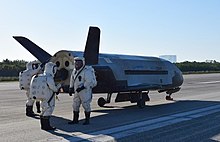U.S. Takes Legal Action To Limit Space Junk - Part 2 of 2 Parts
Part 2 of 2 Parts (Please read Part 1 first)
Part 2 of 2 Parts (Please read Part 1 first)
Part 1 of 2 Parts
There is a cloud of dangerous debris orbiting the Earth. The U.S. government is taking legal steps to limit the amount of space junk after more than six decades of space races, rocket launches, planetary missions and expanding satellite activity.
Part 3 of 3 Parts (Please read Parts 1 and 2 first)

Part 2 of 3 Parts (Please read Part 1 first)
These specifications are taken from official numbers and other figures that are publicly available.
• Length: 29 feet 3 inches
• Wingspan: 14 feet 11 inches
• Height: 9 feet 6 inches
• Payload bay: 7 feet × 4 feet
• Payload capacity: 500 pounds
• Max launch weight: 11,000 pounds
Part 1 of 3 Parts
Part 2 of 2 Parts (Please read Part 1 first)
Part 1 of 2 Parts
Recent research has shown that astronauts are at a higher risk for developing mutation that can increase the risk of developing cancer and heart disease in their lifetimes. This mutation risk may be related to spaceflight. This is a first of its kind study from the Icahn School of Medicine at Mount Sinai revealed the problem.
Last Monday, China denounced NASA's claims it is planning to take over the moon as part of its military space program. The allegations came from NASA Administrator Bill Nelson. He stated Saturday that the US is now involved in a space race with China. He told a German newspaper, “We must be very concerned that China is landing on the moon and saying: 'It's ours now and you stay out'.
Part 2 of 2 Parts (Please read Part 1 first)
Part 1 of 2 Parts
Planetary bodies such as the Moon, Mars, asteroids and comets contain substantial deposits of valuable resources. This has captured the attention of both researchers and industry who hope that they will be mined to support a space economy.